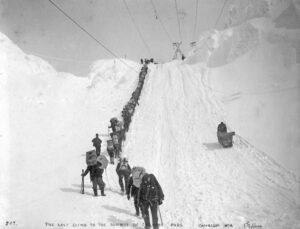fort yukon

 Fort Yukon is a city in the Yukon-Koyukuk Census Area in the state of Alaska. The city actually straddles the Arctic Circle. Most of the people who live there are Alaskan natives from the Gwich’in tribe. This “city” is barely a village by the standards most of us use. In the 2020 census, there were 428 people living there, and that was down from the 2000 census, when the city boasted 595 people. According to the United States Census Bureau, Yukon City occupies a total area of 7.4 square miles, of which 7.0 square miles is land and 0.4 square miles is water. It’s not that “nobody” comes from Fort Yukon, because Fort Yukon was the hometown of the late Alaska Congressman Don Young. Still, I heard someone joke once about asking if any famous people were born in a certain place, and the old man they asked said, “Nope, only babies.” Hahaha!! I suppose that’s true. What we become doesn’t depend on where we were born, but rather on who we choose to become.
Fort Yukon is a city in the Yukon-Koyukuk Census Area in the state of Alaska. The city actually straddles the Arctic Circle. Most of the people who live there are Alaskan natives from the Gwich’in tribe. This “city” is barely a village by the standards most of us use. In the 2020 census, there were 428 people living there, and that was down from the 2000 census, when the city boasted 595 people. According to the United States Census Bureau, Yukon City occupies a total area of 7.4 square miles, of which 7.0 square miles is land and 0.4 square miles is water. It’s not that “nobody” comes from Fort Yukon, because Fort Yukon was the hometown of the late Alaska Congressman Don Young. Still, I heard someone joke once about asking if any famous people were born in a certain place, and the old man they asked said, “Nope, only babies.” Hahaha!! I suppose that’s true. What we become doesn’t depend on where we were born, but rather on who we choose to become.
We normally think of Alaska as a frozen tundra that never thaws, and there are places in Alaska that don’t, but then there are places elsewhere that normally don’t thaw too, and they are much further south than Alaska. While Fort Yukon can have pretty cold temperatures, they also hold the state record for the highest temperature, which was 100°F too. Until 1971, Fort Yukon held the all-time lowest temperature record for Alaska and the United States at ?78 °F, and it still holds the record for the lowest mean monthly temperature when the notoriously cold month of December 1917 had an average daily temperature of ?48.3 °F and the minimum averaged ?58 °F. That has got to be the most extreme temperature shift anywhere. Of course, it didn’t happen in one day, so people might not have noticed that. You would have to brave those really cold temperatures, but if you did, you would find that Fort Yukon is among the best places in the world for observing the Aurora Borealis…someday, maybe I’ll get there for that. In the summer Fort Yukon has midnight sun and in December the sun appears for only a few hours each day…another interesting tidbit of information.
.
Originally Fort Yukon was a trading post established by Alexander Hunter Murray of the Hudson’s Bay Company, on June 25, 1847. He wanted to let people know about the place, so Murray drew numerous sketches of fur trade posts and of people and wrote the Journal of the Yukon, 1847–48, which gave valuable insight into the culture of the Gwich’in at the time. At the time, the post was in Russian America, the Hudson’s Bay Company continued to trade there until the American traders expelled it in 1869, following the Alaska Purchase when the Alaska Commercial Company took over the post.
The Klondike Gold Rush brough the largest influx of people to the area in the winter of 1897–1898. During that time, Fort Yukon received two hundred prospectors from Dawson City, which was short on supplies. A post office was established on July 12, 1898, with John Hawksly as its first postmaster. The settlement suffered over the following decades as a result of several infectious disease epidemics and a 1949 flood, but it was revived in the 1950s, when the United States Air Force established a base and radar station there. The town was officially 
 incorporated in 1959. Probably some of the best things that could have happed to Fort Yukon was its newly established value as a tourist destination, which came about in the late 20th century, due in part to its extreme northerly location and its proximity to Fairbanks. I’ve been to Alaska, but not to this area. Alaska holds a lifelong interest for me, but I’m not sure I could be a full-time resident of the area. Still, I’d like to visit again, and this time maybe in the Winter.
incorporated in 1959. Probably some of the best things that could have happed to Fort Yukon was its newly established value as a tourist destination, which came about in the late 20th century, due in part to its extreme northerly location and its proximity to Fairbanks. I’ve been to Alaska, but not to this area. Alaska holds a lifelong interest for me, but I’m not sure I could be a full-time resident of the area. Still, I’d like to visit again, and this time maybe in the Winter.

